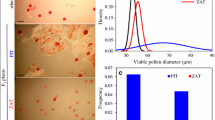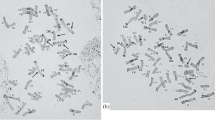Abstract
Mechanisms of two F1 hybrids (D46A × DTP-4 and D46A × Dminghui63) of autotetraploid rice (2n = 4x = 48) showing extremely high pollen fertility 87.40% and 85.97%, respectively, seed set 82.00% and 79.00%, respectively and extremely high level of heterosis were analyzed cytologically. The chromosome pairing of D46A × DTP-4 and D46A × Dminghui63 was normal at metaphase I(MI), and had almost no I or III, with an average of 0.020I +14.36 II 6.44rod+7.91ring) +0.01III + 4.80 IV + 0.01VIII and 0.06 I + 17.67 II (11.01rod + 6.67ring)] + 0.06 III +3.10IV+0.01VI, respectively. The most frequent chromosome configurations were 10II+7IV and 12II+bIV. The bivalent frequency was less frequent in hybrids than that in restoring parents, and the same results were gained from univalents, trivalent and multivalents. However, the quadrivalent frequency was significantly higher in hybrids than that in restoring parents at MI. The other meiotic phases progressed normally, except for low percentages of PMCs with lagging chromosomes at AI and low percentages of PMCs with micronuclei at telophaseI (TI) and telophaseII (TII). PMCs with lagging chromosomes at AI and PMCs with micronuclei at TI and TII showed negative correlation between pollen fertility and seed set. Above 90% of the PMCs could form normal microspores, which resulted in the production of viable pollen grains, abnormal microspores were observed including penta-fission and hexa-fission. Based on these results we suggest that the two F1 hybrids had better behaviors of chromosome pairing and genetic stability than autotetraploid rice and other autotetraploid plants ever studied.
Similar content being viewed by others
References
Alexander MP (1969). Differential staining of aborted and non-aborted pollen. Stain Technol 11: 117–123
Atlagić J and Škorić D (1999). Cytogenetic study of Helianthus laevigatus and its F1 and BC1F1 hybrids with cultivated sunflower, Helianthus annuus. Pl Breed 118: 555–559
Atlagić J, Dozet B and Škorić D (1993). Meiosis and Pollen Viability in Helianthus tuberosus L. and its Hybrids with Cultivated Sunflower. Pl Breed 111: 318–324
Bingham ET, Groose RW, Woodfield DR and Kidwell KK (1994). Complementary gene interactions in alfalfa is greater in autotetraploids than in diploids. Crop Sci 34: 823–829
Birchler JA, Auger DL and Riddle NC (2003). In search of the molecular basis of heterosis. Pl Cell 15: 2236–2239
Chengdu Institute of Biology, Chinese Academy of Sciences (2004) The method of heterosis usage of autotetraploid rice and its induction and breeding. Patent of invention. Application No. 2133770.5 (in Chinese).
Crowley JG and Rees H (1968). Fertility and selection in tetraploid Lolium. Chromosoma 24: 300–308
Darlington CD (1965). Recent advances in cytology. J & A. Churchill, London
Espinasse A, Foueillassar J and Kimber G (1995). Cytogenetical analysis of hybrids between sunflower and for wild relatives. Euphytica 82: 65–72
Fonseca S, Patterson FL (1968) Hybrid vigor in a Seven-barent dialled cross in common winter wheat (Triticum aestivum L.) Crop Sci 8: 85–88
Georgieva-Todorova J (1984) Interspecific hybridization in the genus Helianthus L Z Pflanzenzüchtg 93: 265–279
Georgieva-Todorova J (1990) Genetic and cytogenetic investigation of the genus Helianthus L (in Bulgarian). Bulgarian Acad Sci Sofia.
Ishizaka H (2003). Cytogenetic studies in Cyclamen persicum, C. graecum (Primulaceae) and their hybrids. Pl Syst Evol 239: 1–14
Jenkins G and Chatterjee R (1994). Chromosome structure and pairing preferences in autotetraploid rye (Secale cereale). Genome 37: 748–793
Nayar NM (1981). Origin and cytogenetics of rice. Agronomy Press, Beijing
Ozkan H, Tuna M and Galbraith DW (2006). No DNA loss in autotetraploids of Arabidopsis thaliana. Pl Breed 125: 288–291
Sebastiampillai AR and Jones JK (1977). Cytological studies in the genus Fragaria (Rosaceae) I.Chromosome association and fertility in induced autotetraploids. Cytologia 42: 525–534
Seijo GJ and Solís Neffa VG (2006). Cytogenetic studies in the rare South American Lathyrus hasslerianus Burk. (Leguminosae). Cytologia 71(1): 11–19
Singh RJ (1993) Plant cytogenetics. CRC Press, Inc., pp 255–283
Song ZJ, Du CQ, Dai BC, Chen DL, Chen JG and Cai DT (2006). Studies on the growth habits and characteristics of two polyploidy indica-japonica hybrids with powerful heterosis. Scientia Agricultura Sinica 39(1): 1–9
Song WC and Zhang YH (1992). Rice tetraploidy and its effect an agnonomic traits and nutritional constituents. Acta Agr Sin 18: 137–144 (Chinese with English abstract)
Tu SB, Kong FL, Xu QF and He T (2003). Breakthrough in hybrid rice breeding with autotertraploid. CAS Bull 6: 426–428
Virmani SS, Aquino RC and Khush GS (1982). Heterosis breeding in rice (Oryza sativa L.). Theor Appl Genet 63(4): 373–380
Wallace AJ and Callow RS (1994). Meiotic variation in an intergenomic autopolyploid series. Pairing behaviour. Genome 38: 133–139
Wang B, Haung ChM and Huang QC (1999). Cytological observation on fertilization of autotetraploid rice- I R36. Hunan Agric Sci 5: 9–25
Weimark A (1973). Cytogenetic behaviour in autoploid Triticale I Meiosis, aneuploidy and fertility. Hereditas 74: 103–112
Weimark A (1975). Cytogenetic behaviour in octoploid Triticale I Meiosis with special reference to chiasma frequency and fertility in F1 and parents. Hereditas 80: 121–130
Xiao B, Liu XD, Lu YG, Li JQ and Zhao XJ (2005). Structure and fertilization of embryo sac in intersubspecific hybrids of autotetraploid rice. Acta Agr Sin 31: 1150–1156
Xiao J, Li J, Yuan LP and McCouch SR (1996). Genetic diversity and its relationship to hybrid performance and heterosis in rice as revealed by PCR based markers. Theor Appl Genet 92: 637–643
Zhang HQ and Zhou YH (2006). Meiotic pairing behaviour reveals differences in genomic constitution between Hystrix patula and other species of the genus Hystrix Moench (Poaceae, Triticeae). Pl Syst Evol 258: 129–136
Zhang JY, Jiang GM and Luo YW (1997). Studies on cytogenetics of autotetraploi Sorghum and its hybrids. Acta Agricult Boreali-Sin 12: 1–6
Zhuang JJ, Jia X, Chen GQ and Sun SC (1985). Factors affecting the induction of pollen plants of intergeneric hybrids of Triticum-Agropyron. Theor Appl Genet 70: 289–294
Author information
Authors and Affiliations
Corresponding author
Rights and permissions
About this article
Cite this article
Luan, L., Tu, S., Long, W. et al. Cytogenetic studies on two F1 hybrids of autotetraploid rice varieties showing extremely high level of heterosis. Plant Syst. Evol. 267, 205–213 (2007). https://doi.org/10.1007/s00606-007-0577-3
Received:
Accepted:
Published:
Issue Date:
DOI: https://doi.org/10.1007/s00606-007-0577-3




